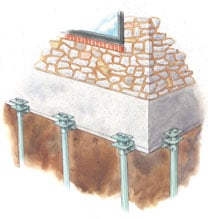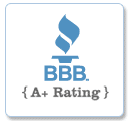
Discovering that your home’s foundation is shifting or settling can feel overwhelming. As cracks spread and floors slope, one big question looms: How do I fix it — and which solution is best for my home?
Among the most trusted repair options, two methods often stand out: pier systems and slabjacking. While both aim to restore stability and correct unevenness, they differ greatly in technique, suitability, and long-term effectiveness. Choosing the wrong method can mean wasted money and unresolved issues, while choosing the right one restores your home’s safety and value.
In this article, we’ll break down how each method works, when to choose one over the other, and what you should know before making a decision.
🔑 Key Takeaways
- Pier systems and slabjacking both address foundation settlement but use different techniques.
- Pier systems (helical and push piers) transfer load to deep, stable soil layers.
- Slabjacking fills voids beneath concrete slabs to lift them back into place.
- Your soil type, damage severity, and foundation design determine the best option.
- Professional assessment is critical before choosing any foundation repair method.
Understanding Foundation Settlement
Before diving into repair methods, it’s important to understand what causes your foundation to move in the first place. Settlement often occurs due to:
- Soil shrinkage and expansion: Common with clay soils that swell when wet and shrink during dry spells.
- Erosion: Water washes away supporting soil beneath the foundation.
- Poor compaction: Fill soils beneath the foundation weren’t properly compacted during construction.
- Excess moisture: Leaking plumbing or poor drainage saturates the soil, weakening support.
As the soil shifts or compresses, the foundation loses its uniform support, leading to cracks, sloping floors, and other structural problems.
Pier Systems: Deep, Structural Stabilization
Pier systems are among the most reliable solutions for addressing significant foundation settlement. These involve driving or drilling piers (steel supports) deep into stable soil or bedrock, effectively bypassing weak or shifting upper soils.
Types of Pier Systems
Push Piers
- How they work: Steel piers are hydraulically driven into the ground until they reach load-bearing strata.
- Best for: Heavy structures and deep settlement issues.
- Advantages: Can potentially lift and re-level the foundation, permanent support, minimal disturbance to landscaping.
Helical Piers
- How they work: Piers with screw-like helices are rotated into the ground, anchoring into firm soil layers.
- Best for: Lighter structures, new construction, and when soil conditions prevent push piers.
- Advantages: Installation doesn’t rely on foundation weight, effective in variable soils, can be used in limited access areas.
When to Use Pier Systems
Pier systems are ideal when:
- Settlement is severe (several inches or more).
- Differential settlement is causing significant structural distortion.
- The soil near the surface is highly unstable or expansive.
- You want a long-term, permanent fix that addresses the underlying cause.
Benefits of Pier Systems
- Long-term stabilization and potential lifting of foundation.
- Prevents further settlement.
- Transfer of load to deeper, stronger soil layers.
- Can correct issues with both foundation walls and interior slabs.
Slabjacking: Lifting Concrete from Below
Slabjacking, also known as mudjacking, is a technique primarily used to lift and level sunken concrete slabs rather than entire foundation walls.
How Slabjacking Works
A mixture of cement, sand, and other additives (or sometimes polyurethane foam) is pumped under the settled slab through small drilled holes. The material fills voids and lifts the slab back to its original level.
When to Use Slabjacking
Slabjacking is appropriate when:
- Only concrete slabs (like garage floors, driveways, patios, or some basement floors) have settled.
- Settlement is relatively minor and uniform.
- There is adequate access beneath the slab to allow lifting.
Benefits of Slabjacking
- Quick and cost-effective solution for non-structural slabs.
- Minimal disruption to landscaping and surrounding areas.
- No need for major excavation.
Limitations of Slabjacking
- Not ideal for addressing settlement in foundation walls or load-bearing structures.
- Does not address underlying soil problems; future settlement is still possible.
- Less effective for large or highly fractured slabs.
Comparing Costs
While exact costs vary based on region, severity, and home size, here’s a general comparison:
| Method | Typical Cost Range |
|---|---|
| Pier Systems | $7,500 – $30,000+ |
| Slabjacking | $1,500 – $7,000 |
While pier systems are more expensive, they address deeper, structural issues and offer permanent support, often backed by long warranties.
Real-Life Case: Choosing the Right Method
A homeowner in Roanoke, VA, noticed their garage floor had sunk by about 2 inches near the entrance, causing pooling water. Meanwhile, cracks in the main foundation walls suggested deeper movement.
After a professional inspection:
- Garage floor: Slabjacking was used to lift and level the concrete slab efficiently.
- Foundation walls: Push piers were installed to stabilize and slightly lift the settled foundation.
By using a tailored approach with both methods, the homeowner restored full functionality and structural integrity without unnecessary costs.
Key Considerations Before Choosing a Method
Soil Type and Condition
Expansive or highly unstable soils usually require pier systems to bypass problematic layers.
Extent of Damage
If your foundation walls have shifted significantly or there is deep settlement, pier systems are usually the only reliable choice.
Structure Type
Lightweight slabs can be effectively lifted with slabjacking, while heavier or load-bearing sections require piers.
Long-Term Goals
If you want a permanent solution that prevents future settlement, pier systems offer the most comprehensive fix.
FAQs: Pier Systems vs. Slabjacking
Can slabjacking be used on foundation walls?
No. Slabjacking is designed for slabs, not for stabilizing or lifting vertical foundation walls.
Will slabjacking prevent future settlement?
No. Slabjacking fills voids and lifts slabs but does not strengthen the soil underneath. Future movement can still occur if underlying conditions remain.
How long do pier systems last?
When properly installed, pier systems are considered permanent solutions and are often backed by lifetime transferable warranties.
Is slabjacking messy?
No. The process involves small drilled holes, and cleanup is minimal. Most projects are completed in a single day.
Can I live in my home during repairs?
Yes. Both methods typically allow homeowners to remain in their home during the repair process.
Conclusion: Choose the Right Method for Lasting Stability
Foundation problems can feel daunting, but understanding your options empowers you to make the right choice for your home.
Pier systems provide deep, permanent stabilization for severe settlement and structural issues. They address the root cause by transferring the load to stable soils far below the surface.
Slabjacking, on the other hand, offers a fast and effective way to lift sunken slabs like garage floors, driveways, and basement floors — but it does not fix deeper foundation problems.
Every home and situation is unique. That’s why an expert evaluation from a trusted foundation repair specialist is essential before starting any work.
If you’ve noticed sinking slabs, cracks in walls, or sloping floors, contact Seal-Tite Basement Waterproofing. Our team can inspect your foundation, explain your options clearly, and design a customized solution that protects your home for decades to come.

Seal-tite Basement Waterproofing Co. is a full service basement environment contractor. We carry an A+ Better Business Bureau rating. We repaired over 40,000 homes and structures in Virginia, West Virginia, Tennessee, and North Carolina. We are fully insured and licensed. We have worked in all types of locations, including residential and commercial locations, government agencies, colleges, hospitals, churches, and condo associations.
Seal-tite® offers a lifetime transferable warranty. We carry a Class A Contractor’s License and we are fully insured. Our satisfied customers range from government agencies to businesses, hospitals, colleges, churches, and thousands of homeowners. Your home is probably the single largest investment you will make in your lifetime. Don’t wait, call Seal-tite® to help make your home dry, safe and livable.

